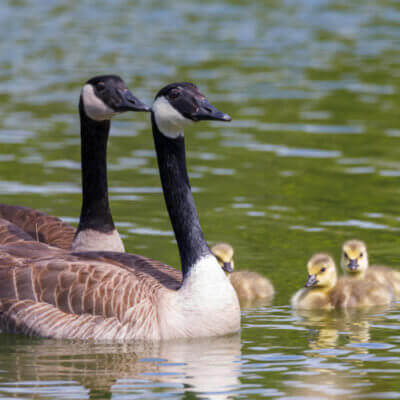Geese Facts & Information
Everything you need to know about geese
WHAT DO geese LOOK LIKE

The Canada goose has an unmistakable black neck and white cheek strap. In flight, Canadas beat their wings deeply and slowly and show a black-and-white tail. More than a dozen different subspecies exist in North America, and their sizes vary from 25 to 45 inches in length. Their familiar call features a deep, two-syllable “ha-ronk,” given by mated pairs as well as flocking birds. Canadas also give a variety of softer cackling calls to each other, especially when they are on the ground.
Located on a high spot near water, the nest features a small mound made of surrounding sticks and vegetation and lined with down plucked from the female. Half a dozen or more eggs are laid and incubated by the female for nearly a month. Meanwhile, the male stands guard and brings her food. Within two days of hatching, young goslings are herded by their parents to the nearest water. Families stay together until the following breeding season, though young birds become self-sufficient in about two months.
Located on a high spot near water, the nest features a small mound made of surrounding sticks and vegetation and lined with down plucked from the female. Half a dozen or more eggs are laid and incubated by the female for nearly a month. Meanwhile, the male stands guard and brings her food. Within two days of hatching, young goslings are herded by their parents to the nearest water. Families stay together until the following breeding season, though young birds become self-sufficient in about two months.
Where do geese live
The Canada goose is a habitat generalist when it comes to water, settling in lakes, bays, rivers, and city parks and ponds. The species has enjoyed unprecedented success in living with or near humans. Today it nests all across the upper two-thirds of North America. Some re-established populations of Canada goose are year-round, non-migratory residents. However, many birds nesting in northern North America migrate to the southern United States in winter. Spring migration begins early, and many females are incubating by mid-March. Some housing developments, golf courses, multifamily properties, commercial properties, and homeowners find them (and their droppings) a nuisance. That’s because they are.
How did I get geese
Geese are on your property to eat or nest, or some combination of both. If you take away their food sources or make their food harder to get, they will not likely choose your land to nest or feed. You can take away or restrict their access to food sources on your property to keep geese from making a home on your land. Geese have a multitude of tendencies that cause them to group together and remain in one area. In addition, since they tend to go back to previous nesting locations, it’s going to take a little more effort to get rid of them.
what Problems do geese cause
Just one goose will deposit 2-4 pounds of feces per day. That sounds like a lot all by itself, but it will really start to build up the more geese you have. Goose poop carries pathogens, parasites, and bacteria, including histoplasmosis and Salmonella. If the excrement gets into your water source, it can be a serious health hazard. Even if your water source isn’t what you drink, it will make algae bloom, which could kill the fish living in it. If you have enough goose droppings around, it can become a liability from a slip and fall perspective. And it’s not just droppings. Should a nest be anywhere near where you are walking, geese can become aggressive. Just like any parent, both the male and female geese will protect the nest. Goose attacks during mating season are not uncommon, making goose control even more important.
Geese can do a number on your landscaping, too! They eat an astonishing amount of grass per day. You pay your landscapers to give you a beautiful lawn, not only to give your building curb appeal but to make it attractive to those walking into it. Geese eat so much grass every day that your lawn will look spotty and sparse. So, at the end of the day, you’re paying your landscapers to create a beautiful lunch for the geese. And if there hasn’t been a lot of rain to dilute it, the Nitrogen content in goose droppings can “burn” yellow spots into your lawn. You want a nice, green lawn – not brown.
Geese can do a number on your landscaping, too! They eat an astonishing amount of grass per day. You pay your landscapers to give you a beautiful lawn, not only to give your building curb appeal but to make it attractive to those walking into it. Geese eat so much grass every day that your lawn will look spotty and sparse. So, at the end of the day, you’re paying your landscapers to create a beautiful lunch for the geese. And if there hasn’t been a lot of rain to dilute it, the Nitrogen content in goose droppings can “burn” yellow spots into your lawn. You want a nice, green lawn – not brown.
How can I prevent geese
Geese are a protected species, so you have to be careful about how you encourage them to vacate your premises. You can try taking away their food source. Geese eat naturally eat grass and water plants. They only need small amounts of mixed corn, floating duck pellets or uncooked plain porridge oats as extras in their diet. Most species of geese are omnivores, but their diet mainly consists of plant matter, particularly seeds, grass, roots, grains, bulbs, berries, and aquatic plants. Canadian geese are herbivores. Geese are sometimes referred to as ‘greedy’; they’re actually notoriously picky eaters! But once they find something they like, that’s when you’ll see the greedy part come out. They will fight other geese and even ducks or other birds in their area to get what they want.
Their intelligence levels, attentiveness, and herding qualities make dogs like Border Collies perfect for herding and chasing Canadian geese. Unfortunately, that only works for the time the dogs are there. Geese will wait, especially if their nest is nearby. As soon as the dog is gone, they will come back. Goose repellent decoys, like dogs, will work for a while. But geese quickly get used to them and will be back – again. They won’t be gone for long, either. The best way to prevent geese is with a product used by the professionals at Western. The geese will never get used to it and it doesn’t harm them. Just gives them enough of a tummy ache to remind them not to eat there again!
Their intelligence levels, attentiveness, and herding qualities make dogs like Border Collies perfect for herding and chasing Canadian geese. Unfortunately, that only works for the time the dogs are there. Geese will wait, especially if their nest is nearby. As soon as the dog is gone, they will come back. Goose repellent decoys, like dogs, will work for a while. But geese quickly get used to them and will be back – again. They won’t be gone for long, either. The best way to prevent geese is with a product used by the professionals at Western. The geese will never get used to it and it doesn’t harm them. Just gives them enough of a tummy ache to remind them not to eat there again!
WHY WESTERN for geese control
We’re passionate about controlling geese around your home or business because we live and work here – it’s our neighborhood, too. With our almost 100 years of experience keeping homes and businesses in Connecticut, Delaware, New Jersey, New York, and Pennsylvania safe from pests, Western has the experience you can trust.
100% Satisfaction Guarantee
24-Hour Guaranteed Response
Board Certified Entomologists
Consider geese removed.
GET A QUOTE
“We installed your Termite Defensive a number of years ago and have not seen even one termite since the system was installed.”
Edison, NJ
